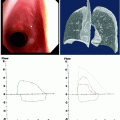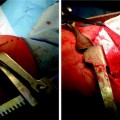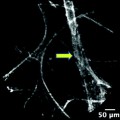Intubation
Surgical anastomotic (i.e., sleeve resection, transplant)
Infectious (i.e., tuberculosis)
Inflammatory (i.e., sarcoidosis, Wegener’s granulomatosis)
Malignant
Idiopathic
Radiation
Inhalational injury
Malignant stenosis
Trauma
Balloon Characteristics
The main characteristic of balloons (Fig. 38.1) used should be that they are of sufficient length to straddle the stenosis, are of a diameter sufficient to dilate the stenosis, are nonconformal, and generate adequate pressure for dilation. Pressure is generated by a dedicated syringe or inflation device allowing the filling of the balloon with solution (water or saline and may be radiopaque) and measurement of pressure (Fig. 38.2). As for length, ideally the balloon should be able to center over the stenosis with sufficient overlap, approximately ≥1 cm on either side of the stenosis and minimize funneling while inflated. The initial diameter should be small enough to start with a gentle dilation and large enough to dilate beyond the initial diameter of the stenosis. Serial larger diameter balloons may be needed with the resultant largest chosen being several millimeters larger than the desired final diameter of the airway. Serial larger dilations may be accomplished by several different balloons of unique diameter or using balloons that have several inherent diameters depending on inflation pressure. A nonconformal balloon is one that dilates to the desired configuration and diameter without molding to the stenosis. Pressure required for dilation is balloon specific and relates to that needed to achieve the diameter desired.
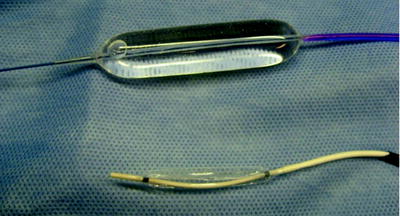
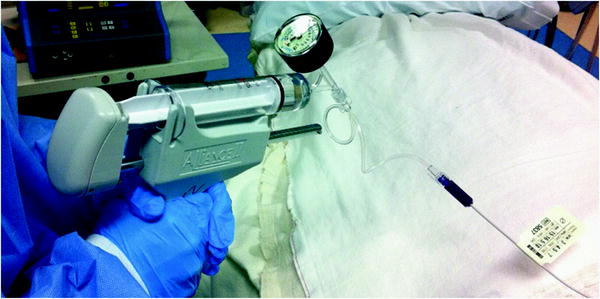

Fig. 38.1
Examples of nonconformal balloons. Above: dilated with saline and over a wire. Below: a different deflated balloon with radiopaque markers at balloon ends (Boston Scientific, Watertown, MA)

Fig. 38.2
Example of an inflation syringe system with built-in pressure gauge (Boston Scientific, Watertown, MA)
Technique
As with all patients, attention to airway stability is paramount. Appropriate monitoring and sedation is required. Patients typically require some form of established airway which can be a laryngeal mask airway, endotracheal tube, or rigid bronchoscope depending on location, experience, and planned intervention. Ideally, the practitioner is skilled in all of these options so the approach chosen can be patient specific. With the exception of a very distal stenosis, patient comfort during dilation necessitates a deep degree of sedation or anesthesia. That is, the typical procedure is done with the assistance of anesthesia support and is preferred with all.
Once the degree and type of stenosis is determined, the approach is chosen. Patients appropriate for balloon bronchoplasty may have this as their only technique used or may have this done in conjunction with other interventions such as airway laser or stenting. In fact, stent deployment or seating may be assisted by the use of a balloon. There are a number of roles for airway balloons (Table 38.2), but as this chapter focuses on balloon dilation, only this will be described.
Table 38.2
Other balloon uses
Stent deployment |
Tamponade of bleeding |
Deliberate airway occlusion |
Foreign body removal |
Many balloons are available on the market for use. Balloons specifically marketed for airway use as well as others designed for vascular or gastroenterologic uses have been employed. Balloons for gastroenterologic or bronchosocpic use are often less expensive than those developed for vascular use. Although the pictures in this chapter show product from one company (Boston Scientific, Watertown, MA), this is not an endorsement of one product set or company. Some fit through the working channels of flexible bronchoscopes (Fig. 38.3), while others require placement via a larger channel either directly or over a wire (Fig. 38.4




Stay updated, free articles. Join our Telegram channel

Full access? Get Clinical Tree



